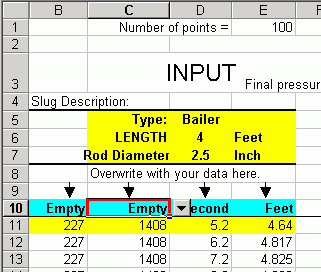Spreadsheets for the Analysis of Aquifer-Test and Slug-Test Data, Version 1.2
Frequently Asked Questions
Q: Do you have the spreadsheets in metric units?
The spreadsheets are designed to handle many different units. Inconsistent input and output units can be used to account for practical field needs and publication specifications. Input units can be controlled on the DATA or OUTPUT pages.

Screen shot: DATA page

Screen shot: OUTPUT page
Output units are defined on the DEFAULT PROPERTIES and SETTINGS page.

Screen shot: DEFAULT PROPERTIES and SETTINGS page
Q: Why is the default number of significant digits 1?
A significant digit of 1 is about the believability of parameter estimates from aquifer tests. The authors believe that reporting more than 1-significant digit is overly bold. If you want to be bold, feel free to change the number of significant digits reported on the DEFAULT PROPERTIES and SETTINGS page.
Q: How do I get a K value with the Bouwer and Rice Slug test sheet when I have more than a 20% discrepancy between the theoretical displacement and the measured displacement?
You can increase the % discrepancy on the DEFAULT PROPERTIES and SETTINGS page. However, you may want to be certain that you have entered your data from the data logger into the spreadsheet correctly. If you start recording data on the data logger prior to slug initiation or there is noise in the data, which results in an oscillation in the first water levels, the data you analyze must start after all of the water levels are moving up or down and no data exceeds an earlier value.

Screen shot: DEFAULT PROPERTIES and SETTINGS page
Q: My data logger only has a time column and water level column, but there are four columns on the data entry sheet. What do I do?
You can select empty for the units of the first two columns and enter your data in the last two columns.

Screen shot: Data entry sheet
 Return to OFR 02-197 Home.
Return to OFR 02-197 Home.
Send questions or comments about this report to the Nevada District Web Team.
For more information about USGS activities in Nevada, visit the USGS Nevada District home page.